Investment Appraisal and Financial Analysis of Madeira Inc. Report
VerifiedAdded on 2023/06/04
|12
|3118
|64
Report
AI Summary
This report provides a comprehensive financial analysis of Madeira Inc., evaluating its financial health and investment opportunities. It includes calculations and analysis of key financial ratios such as gross profit margin, net profit margin, asset turnover, receivable days, payable days, return on capital employed, debt-equity ratio, and return on equity for the years 2019-2021. The report further analyzes the advantages and disadvantages of equity and debt financing, comparing new financing sources with existing ones. Investment appraisal techniques, including payback period, net present value (NPV), and internal rate of return (IRR), are calculated for two projects, providing a comparative analysis to aid in decision-making. The report also discusses the concepts of risk and return, the time value of money, and the advantages of leasing. Ultimately, the analysis aims to provide insights into maximizing shareholder wealth and making informed financial decisions for Madeira Inc. Access similar solved assignments and study resources on Desklib.
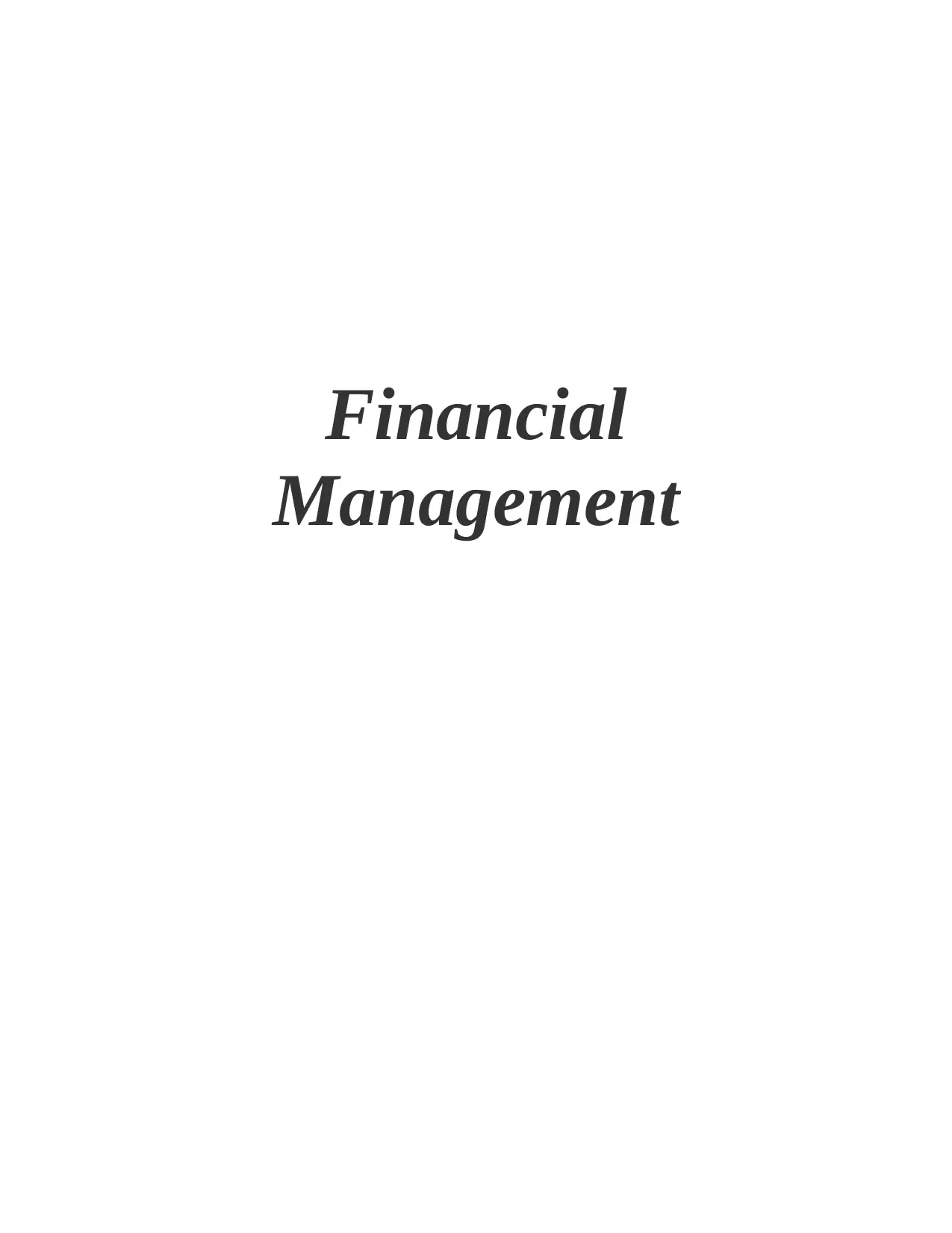
Financial
Management
Management
Paraphrase This Document
Need a fresh take? Get an instant paraphrase of this document with our AI Paraphraser
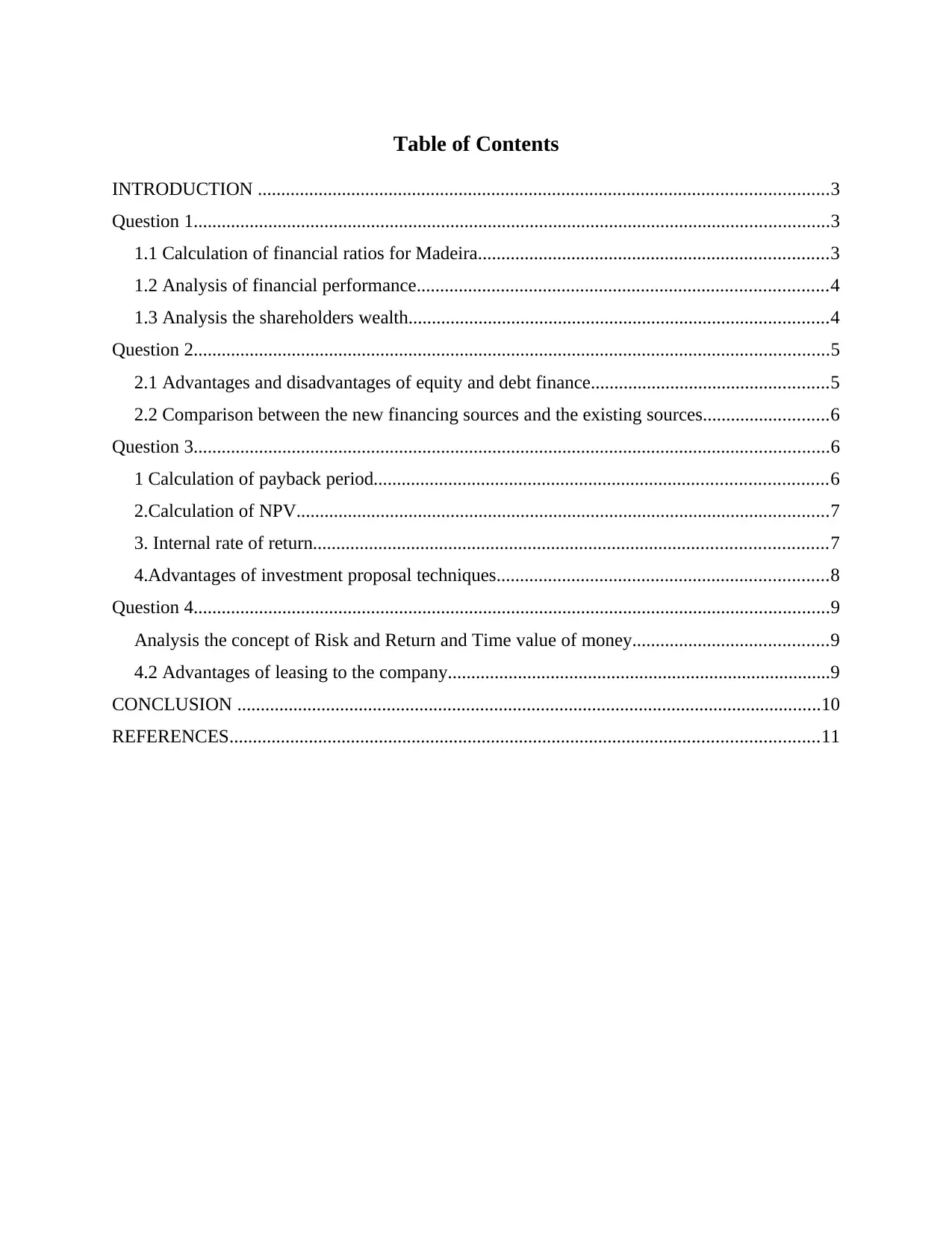
Table of Contents
INTRODUCTION ..........................................................................................................................3
Question 1........................................................................................................................................3
1.1 Calculation of financial ratios for Madeira...........................................................................3
1.2 Analysis of financial performance........................................................................................4
1.3 Analysis the shareholders wealth..........................................................................................4
Question 2........................................................................................................................................5
2.1 Advantages and disadvantages of equity and debt finance...................................................5
2.2 Comparison between the new financing sources and the existing sources...........................6
Question 3........................................................................................................................................6
1 Calculation of payback period.................................................................................................6
2.Calculation of NPV..................................................................................................................7
3. Internal rate of return..............................................................................................................7
4.Advantages of investment proposal techniques.......................................................................8
Question 4........................................................................................................................................9
Analysis the concept of Risk and Return and Time value of money..........................................9
4.2 Advantages of leasing to the company..................................................................................9
CONCLUSION .............................................................................................................................10
REFERENCES..............................................................................................................................11
INTRODUCTION ..........................................................................................................................3
Question 1........................................................................................................................................3
1.1 Calculation of financial ratios for Madeira...........................................................................3
1.2 Analysis of financial performance........................................................................................4
1.3 Analysis the shareholders wealth..........................................................................................4
Question 2........................................................................................................................................5
2.1 Advantages and disadvantages of equity and debt finance...................................................5
2.2 Comparison between the new financing sources and the existing sources...........................6
Question 3........................................................................................................................................6
1 Calculation of payback period.................................................................................................6
2.Calculation of NPV..................................................................................................................7
3. Internal rate of return..............................................................................................................7
4.Advantages of investment proposal techniques.......................................................................8
Question 4........................................................................................................................................9
Analysis the concept of Risk and Return and Time value of money..........................................9
4.2 Advantages of leasing to the company..................................................................................9
CONCLUSION .............................................................................................................................10
REFERENCES..............................................................................................................................11
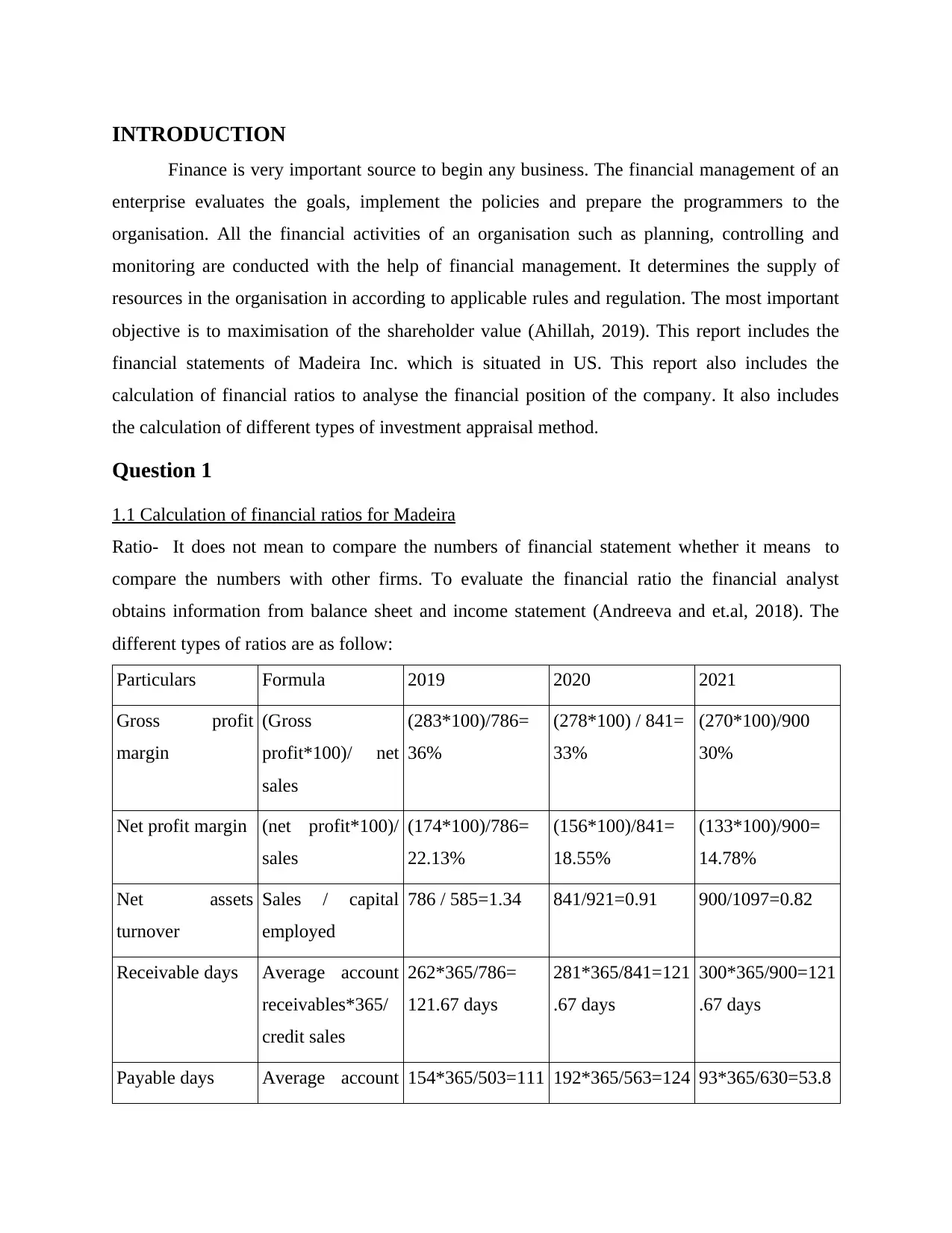
INTRODUCTION
Finance is very important source to begin any business. The financial management of an
enterprise evaluates the goals, implement the policies and prepare the programmers to the
organisation. All the financial activities of an organisation such as planning, controlling and
monitoring are conducted with the help of financial management. It determines the supply of
resources in the organisation in according to applicable rules and regulation. The most important
objective is to maximisation of the shareholder value (Ahillah, 2019). This report includes the
financial statements of Madeira Inc. which is situated in US. This report also includes the
calculation of financial ratios to analyse the financial position of the company. It also includes
the calculation of different types of investment appraisal method.
Question 1
1.1 Calculation of financial ratios for Madeira
Ratio- It does not mean to compare the numbers of financial statement whether it means to
compare the numbers with other firms. To evaluate the financial ratio the financial analyst
obtains information from balance sheet and income statement (Andreeva and et.al, 2018). The
different types of ratios are as follow:
Particulars Formula 2019 2020 2021
Gross profit
margin
(Gross
profit*100)/ net
sales
(283*100)/786=
36%
(278*100) / 841=
33%
(270*100)/900
30%
Net profit margin (net profit*100)/
sales
(174*100)/786=
22.13%
(156*100)/841=
18.55%
(133*100)/900=
14.78%
Net assets
turnover
Sales / capital
employed
786 / 585=1.34 841/921=0.91 900/1097=0.82
Receivable days Average account
receivables*365/
credit sales
262*365/786=
121.67 days
281*365/841=121
.67 days
300*365/900=121
.67 days
Payable days Average account 154*365/503=111 192*365/563=124 93*365/630=53.8
Finance is very important source to begin any business. The financial management of an
enterprise evaluates the goals, implement the policies and prepare the programmers to the
organisation. All the financial activities of an organisation such as planning, controlling and
monitoring are conducted with the help of financial management. It determines the supply of
resources in the organisation in according to applicable rules and regulation. The most important
objective is to maximisation of the shareholder value (Ahillah, 2019). This report includes the
financial statements of Madeira Inc. which is situated in US. This report also includes the
calculation of financial ratios to analyse the financial position of the company. It also includes
the calculation of different types of investment appraisal method.
Question 1
1.1 Calculation of financial ratios for Madeira
Ratio- It does not mean to compare the numbers of financial statement whether it means to
compare the numbers with other firms. To evaluate the financial ratio the financial analyst
obtains information from balance sheet and income statement (Andreeva and et.al, 2018). The
different types of ratios are as follow:
Particulars Formula 2019 2020 2021
Gross profit
margin
(Gross
profit*100)/ net
sales
(283*100)/786=
36%
(278*100) / 841=
33%
(270*100)/900
30%
Net profit margin (net profit*100)/
sales
(174*100)/786=
22.13%
(156*100)/841=
18.55%
(133*100)/900=
14.78%
Net assets
turnover
Sales / capital
employed
786 / 585=1.34 841/921=0.91 900/1097=0.82
Receivable days Average account
receivables*365/
credit sales
262*365/786=
121.67 days
281*365/841=121
.67 days
300*365/900=121
.67 days
Payable days Average account 154*365/503=111 192*365/563=124 93*365/630=53.8
⊘ This is a preview!⊘
Do you want full access?
Subscribe today to unlock all pages.

Trusted by 1+ million students worldwide

payables*365 /
credit purchases
.75 days .48 days 9 days
Return on capital
employed
(PBIT*100)/
capital employed
(174*100)/
585=29.74%
(156*100)/921=
16.94%
(133*100)/1097=
12.12 days
Debt equity ratio Debt / equity 254/485=0.52 604/609=0.99 505/685=0.74
Return on equity (Net profit after
tax- Pd*100)/
equity share
holder funds
(124*100) / 485=
25.57%
(76*100)/609=
12.48%
(53*100) /685=
7.74%
Note: Capital employed= total assets - current liabilities
1.2 Analysis of financial performance
From the above data the company earns more profit in year 2019 because in this year the
cost of sales and other expenses were low in comparing to another years. In every year the
collection period of debtors remain same but in year 2021 the company takes more time to
payment of creditors. In the COVID-19 period the company is generated more return on the total
assets. The equity share holders are earned more dividend in compare to 2020 and 2021. after
analysed all the information, in 2021 the performance of the company was very poor. To
improve the performance, the company should reduced its debenture and capital raise through
equity shareholders so that company can save the interest expenses and earn high profit to the
equity shareholders (Baker, Kumar and Pandey, 2020).
1.3 Analysis the shareholders wealth
The most important aim of financial management is to increase the equity shareholders
wealth. The decision will be taken on the basis of funds invested. The prices of the shares are
based on the return earned on investment. The company is increasing the price of shareholders
because they wants increase the profitability and maintain the liquidity position (Birkenmaier
and Fu, 2019). For a long time the corporate dividend policy has been an issue of interest in the
financial literature. In corporate finance and among many academics the dividend policy has
become one of the most debate topics. The expected future returns to the owners of the firm is
defined as shareholder wealth. The market value of the firm's common stock is measured by the
market value of shareholder wealth. The shareholder wealth like dividend per share, return on
credit purchases
.75 days .48 days 9 days
Return on capital
employed
(PBIT*100)/
capital employed
(174*100)/
585=29.74%
(156*100)/921=
16.94%
(133*100)/1097=
12.12 days
Debt equity ratio Debt / equity 254/485=0.52 604/609=0.99 505/685=0.74
Return on equity (Net profit after
tax- Pd*100)/
equity share
holder funds
(124*100) / 485=
25.57%
(76*100)/609=
12.48%
(53*100) /685=
7.74%
Note: Capital employed= total assets - current liabilities
1.2 Analysis of financial performance
From the above data the company earns more profit in year 2019 because in this year the
cost of sales and other expenses were low in comparing to another years. In every year the
collection period of debtors remain same but in year 2021 the company takes more time to
payment of creditors. In the COVID-19 period the company is generated more return on the total
assets. The equity share holders are earned more dividend in compare to 2020 and 2021. after
analysed all the information, in 2021 the performance of the company was very poor. To
improve the performance, the company should reduced its debenture and capital raise through
equity shareholders so that company can save the interest expenses and earn high profit to the
equity shareholders (Baker, Kumar and Pandey, 2020).
1.3 Analysis the shareholders wealth
The most important aim of financial management is to increase the equity shareholders
wealth. The decision will be taken on the basis of funds invested. The prices of the shares are
based on the return earned on investment. The company is increasing the price of shareholders
because they wants increase the profitability and maintain the liquidity position (Birkenmaier
and Fu, 2019). For a long time the corporate dividend policy has been an issue of interest in the
financial literature. In corporate finance and among many academics the dividend policy has
become one of the most debate topics. The expected future returns to the owners of the firm is
defined as shareholder wealth. The market value of the firm's common stock is measured by the
market value of shareholder wealth. The shareholder wealth like dividend per share, return on
Paraphrase This Document
Need a fresh take? Get an instant paraphrase of this document with our AI Paraphraser
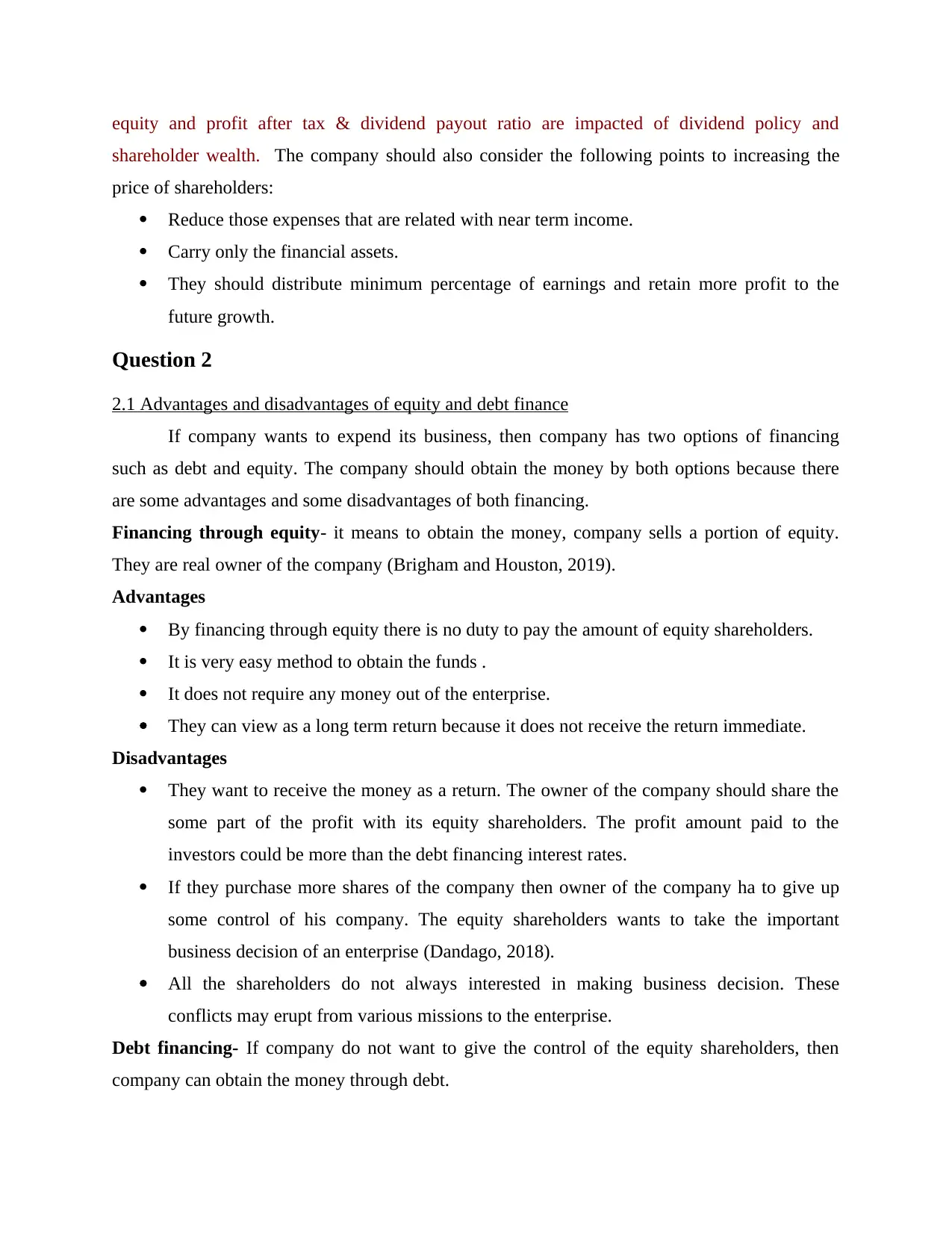
equity and profit after tax & dividend payout ratio are impacted of dividend policy and
shareholder wealth. The company should also consider the following points to increasing the
price of shareholders:
Reduce those expenses that are related with near term income.
Carry only the financial assets.
They should distribute minimum percentage of earnings and retain more profit to the
future growth.
Question 2
2.1 Advantages and disadvantages of equity and debt finance
If company wants to expend its business, then company has two options of financing
such as debt and equity. The company should obtain the money by both options because there
are some advantages and some disadvantages of both financing.
Financing through equity- it means to obtain the money, company sells a portion of equity.
They are real owner of the company (Brigham and Houston, 2019).
Advantages
By financing through equity there is no duty to pay the amount of equity shareholders.
It is very easy method to obtain the funds .
It does not require any money out of the enterprise.
They can view as a long term return because it does not receive the return immediate.
Disadvantages
They want to receive the money as a return. The owner of the company should share the
some part of the profit with its equity shareholders. The profit amount paid to the
investors could be more than the debt financing interest rates.
If they purchase more shares of the company then owner of the company ha to give up
some control of his company. The equity shareholders wants to take the important
business decision of an enterprise (Dandago, 2018).
All the shareholders do not always interested in making business decision. These
conflicts may erupt from various missions to the enterprise.
Debt financing- If company do not want to give the control of the equity shareholders, then
company can obtain the money through debt.
shareholder wealth. The company should also consider the following points to increasing the
price of shareholders:
Reduce those expenses that are related with near term income.
Carry only the financial assets.
They should distribute minimum percentage of earnings and retain more profit to the
future growth.
Question 2
2.1 Advantages and disadvantages of equity and debt finance
If company wants to expend its business, then company has two options of financing
such as debt and equity. The company should obtain the money by both options because there
are some advantages and some disadvantages of both financing.
Financing through equity- it means to obtain the money, company sells a portion of equity.
They are real owner of the company (Brigham and Houston, 2019).
Advantages
By financing through equity there is no duty to pay the amount of equity shareholders.
It is very easy method to obtain the funds .
It does not require any money out of the enterprise.
They can view as a long term return because it does not receive the return immediate.
Disadvantages
They want to receive the money as a return. The owner of the company should share the
some part of the profit with its equity shareholders. The profit amount paid to the
investors could be more than the debt financing interest rates.
If they purchase more shares of the company then owner of the company ha to give up
some control of his company. The equity shareholders wants to take the important
business decision of an enterprise (Dandago, 2018).
All the shareholders do not always interested in making business decision. These
conflicts may erupt from various missions to the enterprise.
Debt financing- If company do not want to give the control of the equity shareholders, then
company can obtain the money through debt.

Advantages
It is temporary loan. The relationship with debentures ends when the company repays the
loan. The debenture holder cannot say in how the manager survive his business.
It saves the tax because debt interest is always tax deductible.
It may be related with long,medium and short term.
Disadvantages
The interest and principal amount always pay in specified time whether company earns
profit or not. If company does not have sufficient cash to pay the loan then it creates
problem to the owner of the company.
Some lenders demand that fixed assets of the organisation be held as collateral and
manger is required to take the personal guarantee (Okanazu, 2018).
In according to above information if Madeira wants to invest 1 billion USD in the
upcoming years. The company obtains the money by both financing. But company should obtain
the more money through equity financing so that company can save the interest expenses and
generate more revenue. In year 2021 the debt equity ratio is 0.745 that is more than in comparing
to 2019 and 2020. To maintain the liquidity company should finance 75% that is 3.75 billion
USD through equity share and remaining 25 % (1.25) billion USD through debt financing.
2.2 Comparison between the new financing sources and the existing sources
Company must to obtain external sources to expand their growth of the organisation into new
locations. It also includes them research and development investment. And while enterprises do
objective to utilise the profits from ongoing business activities to fund such projects, it is more
best to obtain the money of the eternal debt financing. All the industries belong different sectors,
there are some financing sources all available. If company obtains the money only equity share
holders then cost of the equity is 7.74% and if company uses both sources of finance then cost of
the finance will come relatively low. If company obtains the money new approach then company
will pay the low interest and low dividend to its shareholder and its debenture holder. The
company should adopt those strategies which gives high return. So that company should finance
through both equity and debt (Riinawati, 2022).
It is temporary loan. The relationship with debentures ends when the company repays the
loan. The debenture holder cannot say in how the manager survive his business.
It saves the tax because debt interest is always tax deductible.
It may be related with long,medium and short term.
Disadvantages
The interest and principal amount always pay in specified time whether company earns
profit or not. If company does not have sufficient cash to pay the loan then it creates
problem to the owner of the company.
Some lenders demand that fixed assets of the organisation be held as collateral and
manger is required to take the personal guarantee (Okanazu, 2018).
In according to above information if Madeira wants to invest 1 billion USD in the
upcoming years. The company obtains the money by both financing. But company should obtain
the more money through equity financing so that company can save the interest expenses and
generate more revenue. In year 2021 the debt equity ratio is 0.745 that is more than in comparing
to 2019 and 2020. To maintain the liquidity company should finance 75% that is 3.75 billion
USD through equity share and remaining 25 % (1.25) billion USD through debt financing.
2.2 Comparison between the new financing sources and the existing sources
Company must to obtain external sources to expand their growth of the organisation into new
locations. It also includes them research and development investment. And while enterprises do
objective to utilise the profits from ongoing business activities to fund such projects, it is more
best to obtain the money of the eternal debt financing. All the industries belong different sectors,
there are some financing sources all available. If company obtains the money only equity share
holders then cost of the equity is 7.74% and if company uses both sources of finance then cost of
the finance will come relatively low. If company obtains the money new approach then company
will pay the low interest and low dividend to its shareholder and its debenture holder. The
company should adopt those strategies which gives high return. So that company should finance
through both equity and debt (Riinawati, 2022).
⊘ This is a preview!⊘
Do you want full access?
Subscribe today to unlock all pages.

Trusted by 1+ million students worldwide
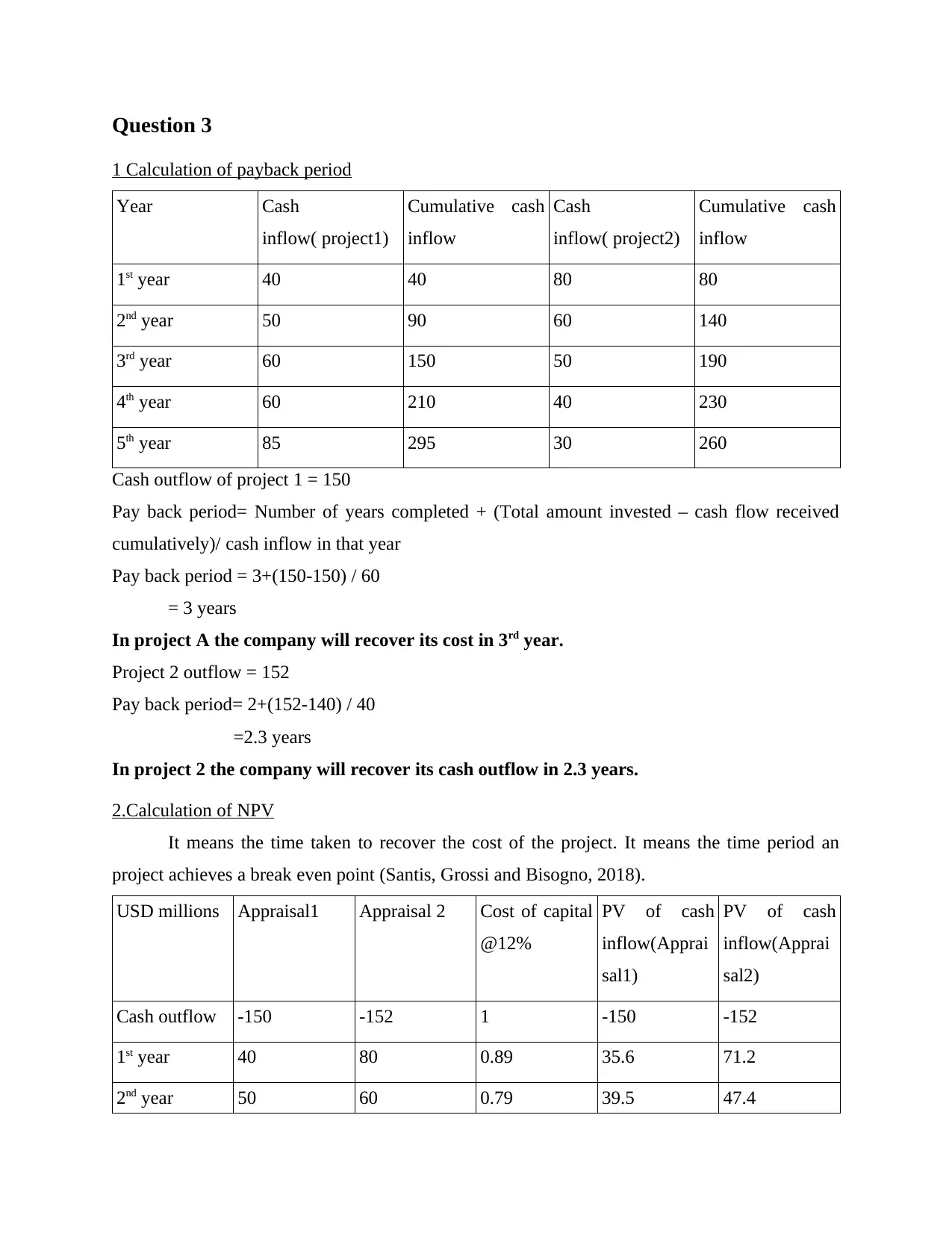
Question 3
1 Calculation of payback period
Year Cash
inflow( project1)
Cumulative cash
inflow
Cash
inflow( project2)
Cumulative cash
inflow
1st year 40 40 80 80
2nd year 50 90 60 140
3rd year 60 150 50 190
4th year 60 210 40 230
5th year 85 295 30 260
Cash outflow of project 1 = 150
Pay back period= Number of years completed + (Total amount invested – cash flow received
cumulatively)/ cash inflow in that year
Pay back period = 3+(150-150) / 60
= 3 years
In project A the company will recover its cost in 3rd year.
Project 2 outflow = 152
Pay back period= 2+(152-140) / 40
=2.3 years
In project 2 the company will recover its cash outflow in 2.3 years.
2.Calculation of NPV
It means the time taken to recover the cost of the project. It means the time period an
project achieves a break even point (Santis, Grossi and Bisogno, 2018).
USD millions Appraisal1 Appraisal 2 Cost of capital
@12%
PV of cash
inflow(Apprai
sal1)
PV of cash
inflow(Apprai
sal2)
Cash outflow -150 -152 1 -150 -152
1st year 40 80 0.89 35.6 71.2
2nd year 50 60 0.79 39.5 47.4
1 Calculation of payback period
Year Cash
inflow( project1)
Cumulative cash
inflow
Cash
inflow( project2)
Cumulative cash
inflow
1st year 40 40 80 80
2nd year 50 90 60 140
3rd year 60 150 50 190
4th year 60 210 40 230
5th year 85 295 30 260
Cash outflow of project 1 = 150
Pay back period= Number of years completed + (Total amount invested – cash flow received
cumulatively)/ cash inflow in that year
Pay back period = 3+(150-150) / 60
= 3 years
In project A the company will recover its cost in 3rd year.
Project 2 outflow = 152
Pay back period= 2+(152-140) / 40
=2.3 years
In project 2 the company will recover its cash outflow in 2.3 years.
2.Calculation of NPV
It means the time taken to recover the cost of the project. It means the time period an
project achieves a break even point (Santis, Grossi and Bisogno, 2018).
USD millions Appraisal1 Appraisal 2 Cost of capital
@12%
PV of cash
inflow(Apprai
sal1)
PV of cash
inflow(Apprai
sal2)
Cash outflow -150 -152 1 -150 -152
1st year 40 80 0.89 35.6 71.2
2nd year 50 60 0.79 39.5 47.4
Paraphrase This Document
Need a fresh take? Get an instant paraphrase of this document with our AI Paraphraser
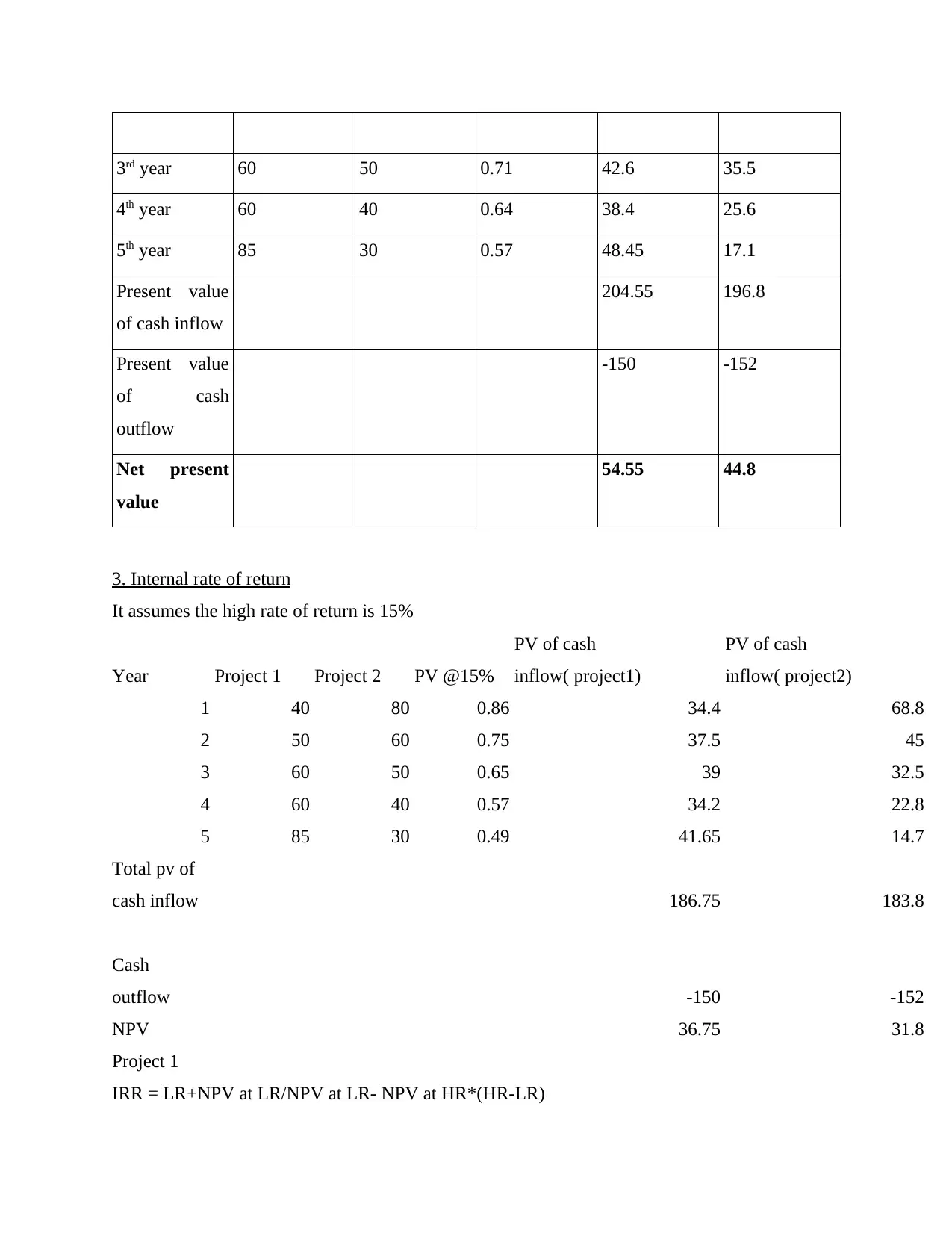
3rd year 60 50 0.71 42.6 35.5
4th year 60 40 0.64 38.4 25.6
5th year 85 30 0.57 48.45 17.1
Present value
of cash inflow
204.55 196.8
Present value
of cash
outflow
-150 -152
Net present
value
54.55 44.8
3. Internal rate of return
It assumes the high rate of return is 15%
Year Project 1 Project 2 PV @15%
PV of cash
inflow( project1)
PV of cash
inflow( project2)
1 40 80 0.86 34.4 68.8
2 50 60 0.75 37.5 45
3 60 50 0.65 39 32.5
4 60 40 0.57 34.2 22.8
5 85 30 0.49 41.65 14.7
Total pv of
cash inflow 186.75 183.8
Cash
outflow -150 -152
NPV 36.75 31.8
Project 1
IRR = LR+NPV at LR/NPV at LR- NPV at HR*(HR-LR)
4th year 60 40 0.64 38.4 25.6
5th year 85 30 0.57 48.45 17.1
Present value
of cash inflow
204.55 196.8
Present value
of cash
outflow
-150 -152
Net present
value
54.55 44.8
3. Internal rate of return
It assumes the high rate of return is 15%
Year Project 1 Project 2 PV @15%
PV of cash
inflow( project1)
PV of cash
inflow( project2)
1 40 80 0.86 34.4 68.8
2 50 60 0.75 37.5 45
3 60 50 0.65 39 32.5
4 60 40 0.57 34.2 22.8
5 85 30 0.49 41.65 14.7
Total pv of
cash inflow 186.75 183.8
Cash
outflow -150 -152
NPV 36.75 31.8
Project 1
IRR = LR+NPV at LR/NPV at LR- NPV at HR*(HR-LR)
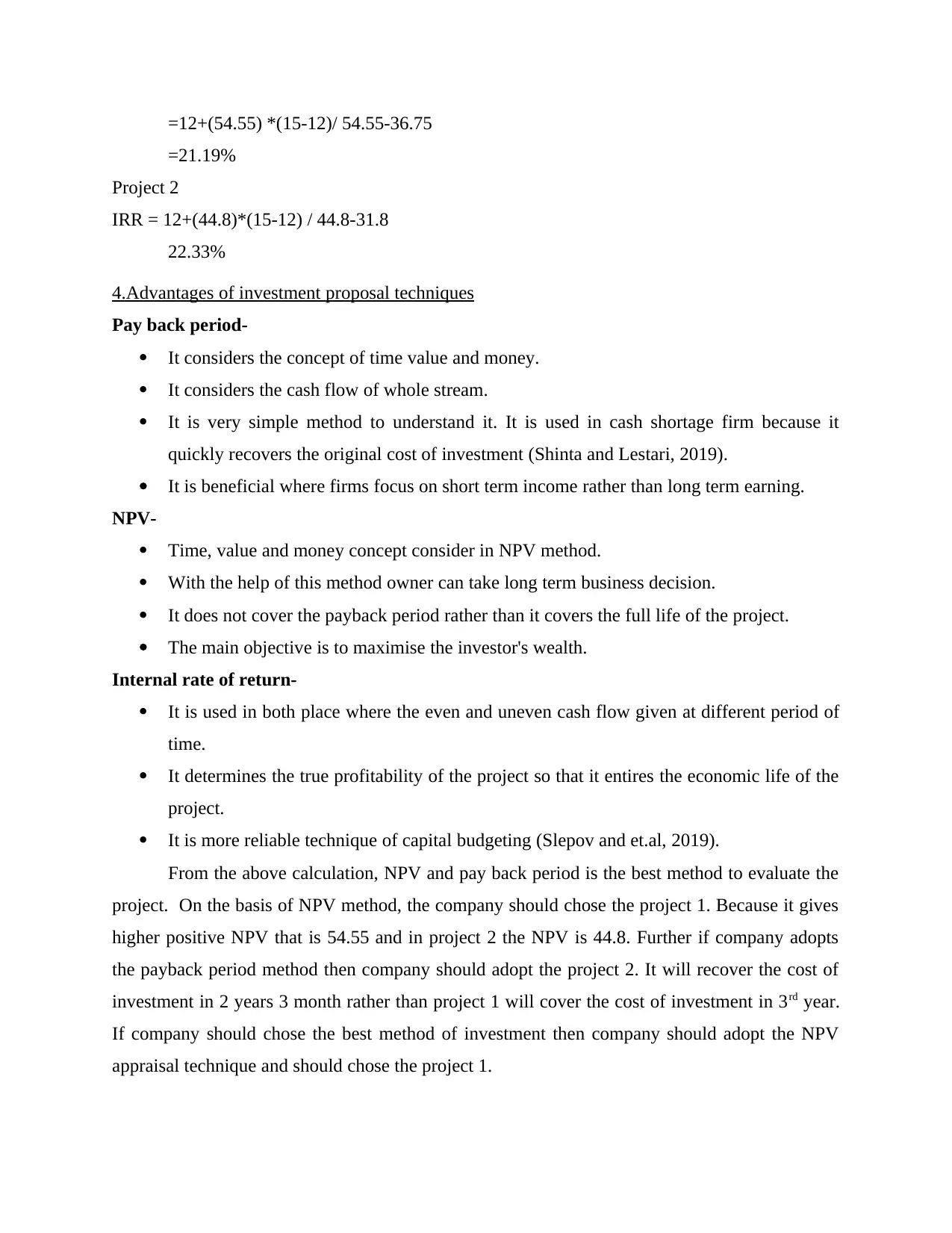
=12+(54.55) *(15-12)/ 54.55-36.75
=21.19%
Project 2
IRR = 12+(44.8)*(15-12) / 44.8-31.8
22.33%
4.Advantages of investment proposal techniques
Pay back period-
It considers the concept of time value and money.
It considers the cash flow of whole stream.
It is very simple method to understand it. It is used in cash shortage firm because it
quickly recovers the original cost of investment (Shinta and Lestari, 2019).
It is beneficial where firms focus on short term income rather than long term earning.
NPV-
Time, value and money concept consider in NPV method.
With the help of this method owner can take long term business decision.
It does not cover the payback period rather than it covers the full life of the project.
The main objective is to maximise the investor's wealth.
Internal rate of return-
It is used in both place where the even and uneven cash flow given at different period of
time.
It determines the true profitability of the project so that it entires the economic life of the
project.
It is more reliable technique of capital budgeting (Slepov and et.al, 2019).
From the above calculation, NPV and pay back period is the best method to evaluate the
project. On the basis of NPV method, the company should chose the project 1. Because it gives
higher positive NPV that is 54.55 and in project 2 the NPV is 44.8. Further if company adopts
the payback period method then company should adopt the project 2. It will recover the cost of
investment in 2 years 3 month rather than project 1 will cover the cost of investment in 3rd year.
If company should chose the best method of investment then company should adopt the NPV
appraisal technique and should chose the project 1.
=21.19%
Project 2
IRR = 12+(44.8)*(15-12) / 44.8-31.8
22.33%
4.Advantages of investment proposal techniques
Pay back period-
It considers the concept of time value and money.
It considers the cash flow of whole stream.
It is very simple method to understand it. It is used in cash shortage firm because it
quickly recovers the original cost of investment (Shinta and Lestari, 2019).
It is beneficial where firms focus on short term income rather than long term earning.
NPV-
Time, value and money concept consider in NPV method.
With the help of this method owner can take long term business decision.
It does not cover the payback period rather than it covers the full life of the project.
The main objective is to maximise the investor's wealth.
Internal rate of return-
It is used in both place where the even and uneven cash flow given at different period of
time.
It determines the true profitability of the project so that it entires the economic life of the
project.
It is more reliable technique of capital budgeting (Slepov and et.al, 2019).
From the above calculation, NPV and pay back period is the best method to evaluate the
project. On the basis of NPV method, the company should chose the project 1. Because it gives
higher positive NPV that is 54.55 and in project 2 the NPV is 44.8. Further if company adopts
the payback period method then company should adopt the project 2. It will recover the cost of
investment in 2 years 3 month rather than project 1 will cover the cost of investment in 3rd year.
If company should chose the best method of investment then company should adopt the NPV
appraisal technique and should chose the project 1.
⊘ This is a preview!⊘
Do you want full access?
Subscribe today to unlock all pages.

Trusted by 1+ million students worldwide

Question 4
Analysis the concept of Risk and Return and Time value of money
Risk and return are very important concept on investment appraisal technique. Both term
are interrelated with other other. If returns of the investment is increased then risk will
automatically increase. There are various types of risk in the project such as competitive risk,
market risk and international risk. Return means to either profits or losses from security of
trading. It always shows in the percentage form. The different factors affect the type of returns
but company choose the appropriate method which gives the high return and lower risk. Inflation
and purchasing power are also related the concept of time value of money. Because inflation
constantly erodes the value, and therefore the purchasing power, of money
4.2 Advantages of leasing to the company
Leasing- It is the best method to resolve capital assets requirement. When company
analysing this technique, it is essential to the manager of the capital to understand whether this
proposal would give good returns on capital or not.
Advantages-
1. Capital saving- It provides hundred percent finance and covers the full cost of the fixed
assets used in the business. In this way the owner can save the money and utilised fund in
another purpose such as acquire of stock (Vakhrushina and et.al, 2018).
2. Working capital requirement- with the help of leasing company can utilised the entire
fund to fulfilled the working capital requirements.
3. Budgeting: With fixed (monthly, quarterly, annual) payments, cash flow is more
predictable making budgeting easier.
4. Certainty of payment: The interest rate and payments are known for the term of the lease
regardless of fluctuations in market interest rate.
CONCLUSION
From the above report it is concluded, the investment appraisal techniques play an
important role in the company. If company should choose the best project, company have
available various options but they select the best method which gives the high return of
investment. This report is also included the calculation of ratios to evaluate the financial
performance of the company. The advantages of leasing company is also included.
Analysis the concept of Risk and Return and Time value of money
Risk and return are very important concept on investment appraisal technique. Both term
are interrelated with other other. If returns of the investment is increased then risk will
automatically increase. There are various types of risk in the project such as competitive risk,
market risk and international risk. Return means to either profits or losses from security of
trading. It always shows in the percentage form. The different factors affect the type of returns
but company choose the appropriate method which gives the high return and lower risk. Inflation
and purchasing power are also related the concept of time value of money. Because inflation
constantly erodes the value, and therefore the purchasing power, of money
4.2 Advantages of leasing to the company
Leasing- It is the best method to resolve capital assets requirement. When company
analysing this technique, it is essential to the manager of the capital to understand whether this
proposal would give good returns on capital or not.
Advantages-
1. Capital saving- It provides hundred percent finance and covers the full cost of the fixed
assets used in the business. In this way the owner can save the money and utilised fund in
another purpose such as acquire of stock (Vakhrushina and et.al, 2018).
2. Working capital requirement- with the help of leasing company can utilised the entire
fund to fulfilled the working capital requirements.
3. Budgeting: With fixed (monthly, quarterly, annual) payments, cash flow is more
predictable making budgeting easier.
4. Certainty of payment: The interest rate and payments are known for the term of the lease
regardless of fluctuations in market interest rate.
CONCLUSION
From the above report it is concluded, the investment appraisal techniques play an
important role in the company. If company should choose the best project, company have
available various options but they select the best method which gives the high return of
investment. This report is also included the calculation of ratios to evaluate the financial
performance of the company. The advantages of leasing company is also included.
Paraphrase This Document
Need a fresh take? Get an instant paraphrase of this document with our AI Paraphraser

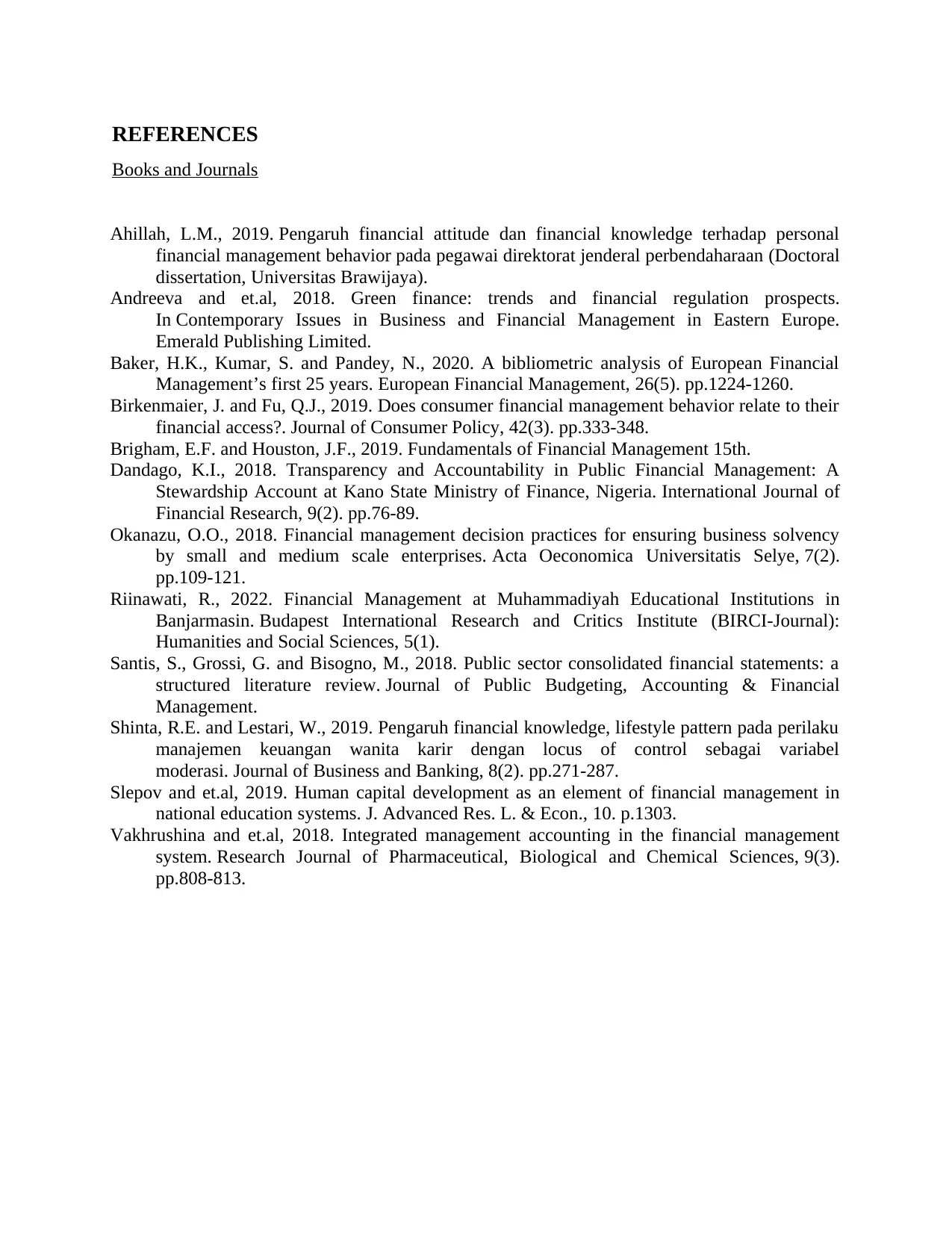
REFERENCES
Books and Journals
Ahillah, L.M., 2019. Pengaruh financial attitude dan financial knowledge terhadap personal
financial management behavior pada pegawai direktorat jenderal perbendaharaan (Doctoral
dissertation, Universitas Brawijaya).
Andreeva and et.al, 2018. Green finance: trends and financial regulation prospects.
In Contemporary Issues in Business and Financial Management in Eastern Europe.
Emerald Publishing Limited.
Baker, H.K., Kumar, S. and Pandey, N., 2020. A bibliometric analysis of European Financial
Managementʼs first 25 years. European Financial Management, 26(5). pp.1224-1260.
Birkenmaier, J. and Fu, Q.J., 2019. Does consumer financial management behavior relate to their
financial access?. Journal of Consumer Policy, 42(3). pp.333-348.
Brigham, E.F. and Houston, J.F., 2019. Fundamentals of Financial Management 15th.
Dandago, K.I., 2018. Transparency and Accountability in Public Financial Management: A
Stewardship Account at Kano State Ministry of Finance, Nigeria. International Journal of
Financial Research, 9(2). pp.76-89.
Okanazu, O.O., 2018. Financial management decision practices for ensuring business solvency
by small and medium scale enterprises. Acta Oeconomica Universitatis Selye, 7(2).
pp.109-121.
Riinawati, R., 2022. Financial Management at Muhammadiyah Educational Institutions in
Banjarmasin. Budapest International Research and Critics Institute (BIRCI-Journal):
Humanities and Social Sciences, 5(1).
Santis, S., Grossi, G. and Bisogno, M., 2018. Public sector consolidated financial statements: a
structured literature review. Journal of Public Budgeting, Accounting & Financial
Management.
Shinta, R.E. and Lestari, W., 2019. Pengaruh financial knowledge, lifestyle pattern pada perilaku
manajemen keuangan wanita karir dengan locus of control sebagai variabel
moderasi. Journal of Business and Banking, 8(2). pp.271-287.
Slepov and et.al, 2019. Human capital development as an element of financial management in
national education systems. J. Advanced Res. L. & Econ., 10. p.1303.
Vakhrushina and et.al, 2018. Integrated management accounting in the financial management
system. Research Journal of Pharmaceutical, Biological and Chemical Sciences, 9(3).
pp.808-813.
Books and Journals
Ahillah, L.M., 2019. Pengaruh financial attitude dan financial knowledge terhadap personal
financial management behavior pada pegawai direktorat jenderal perbendaharaan (Doctoral
dissertation, Universitas Brawijaya).
Andreeva and et.al, 2018. Green finance: trends and financial regulation prospects.
In Contemporary Issues in Business and Financial Management in Eastern Europe.
Emerald Publishing Limited.
Baker, H.K., Kumar, S. and Pandey, N., 2020. A bibliometric analysis of European Financial
Managementʼs first 25 years. European Financial Management, 26(5). pp.1224-1260.
Birkenmaier, J. and Fu, Q.J., 2019. Does consumer financial management behavior relate to their
financial access?. Journal of Consumer Policy, 42(3). pp.333-348.
Brigham, E.F. and Houston, J.F., 2019. Fundamentals of Financial Management 15th.
Dandago, K.I., 2018. Transparency and Accountability in Public Financial Management: A
Stewardship Account at Kano State Ministry of Finance, Nigeria. International Journal of
Financial Research, 9(2). pp.76-89.
Okanazu, O.O., 2018. Financial management decision practices for ensuring business solvency
by small and medium scale enterprises. Acta Oeconomica Universitatis Selye, 7(2).
pp.109-121.
Riinawati, R., 2022. Financial Management at Muhammadiyah Educational Institutions in
Banjarmasin. Budapest International Research and Critics Institute (BIRCI-Journal):
Humanities and Social Sciences, 5(1).
Santis, S., Grossi, G. and Bisogno, M., 2018. Public sector consolidated financial statements: a
structured literature review. Journal of Public Budgeting, Accounting & Financial
Management.
Shinta, R.E. and Lestari, W., 2019. Pengaruh financial knowledge, lifestyle pattern pada perilaku
manajemen keuangan wanita karir dengan locus of control sebagai variabel
moderasi. Journal of Business and Banking, 8(2). pp.271-287.
Slepov and et.al, 2019. Human capital development as an element of financial management in
national education systems. J. Advanced Res. L. & Econ., 10. p.1303.
Vakhrushina and et.al, 2018. Integrated management accounting in the financial management
system. Research Journal of Pharmaceutical, Biological and Chemical Sciences, 9(3).
pp.808-813.
⊘ This is a preview!⊘
Do you want full access?
Subscribe today to unlock all pages.

Trusted by 1+ million students worldwide
1 out of 12